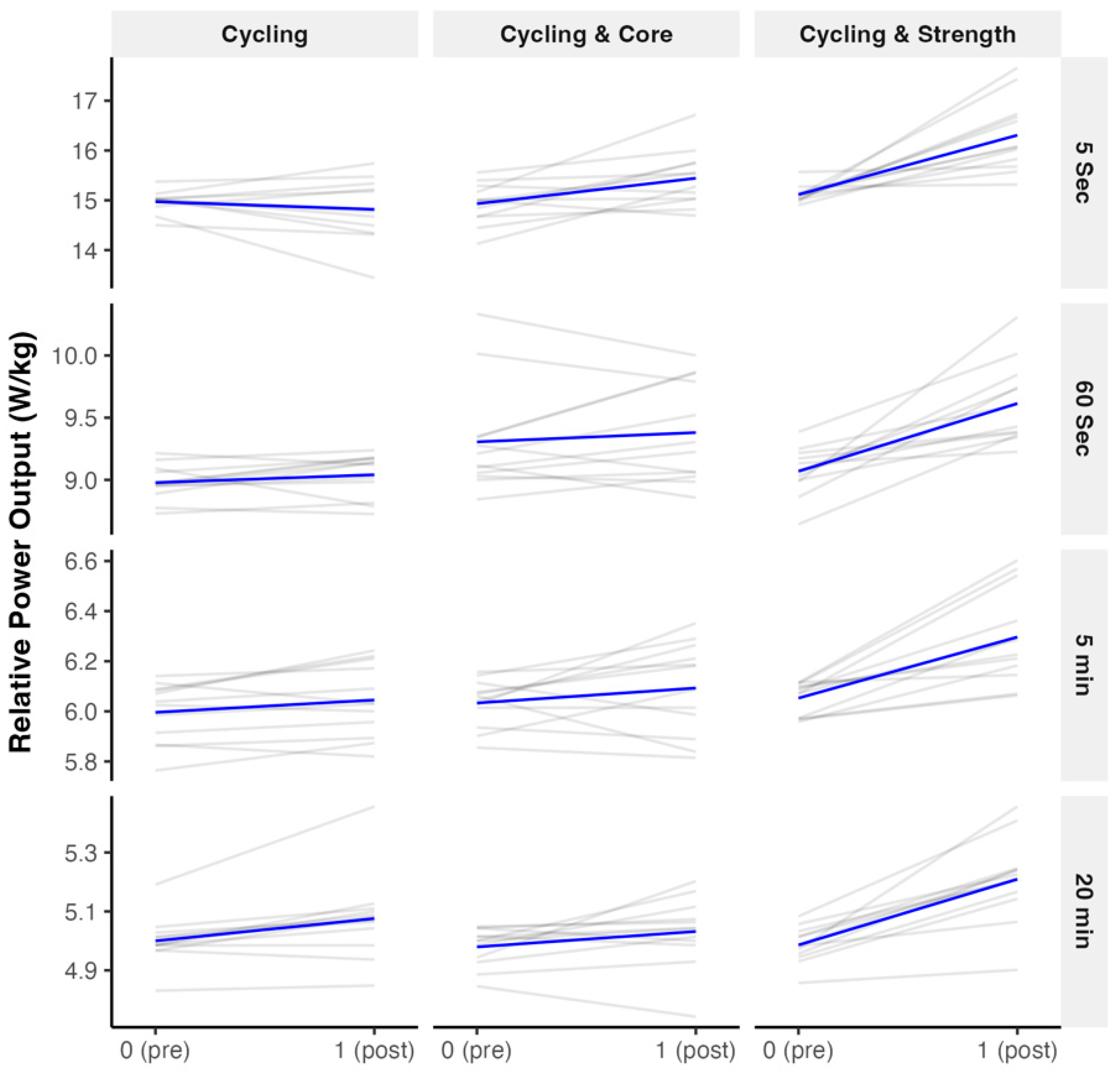Submitted:
28 December 2023
Posted:
28 December 2023
You are already at the latest version
Abstract
Keywords:
1. Introduction
2. Materials and Methods
2.1. Participants
2.2. Procedures
2.3. Anthropometric Evaluation
2.4. Endurance Training
2.5. Strength Training
2.6. Core Training
2.7. Statistical Analyses
3. Results
3.1. Anthropometric Data
3.2. Main Relative Power Output Differences
3.3. Post-Hoc Group Contrasts by Variable
4. Discussion
5. Conclusions
Author Contributions
Funding
Institutional Review Board Statement
Informed Consent Statement
Acknowledgments
Conflicts of Interest
References
- Aagaard, P.; Andersen, J.L.; Bennekou, M.; Larsson, B.; Olesen, J.L.; Crameri, R.; Magnusson, S.P.; Kjær, M. Effects of resistance training on endurance capacity and muscle fiber composition in young top-level cyclists. Scand. J. Med. Sci. Sports 2011, 21, e298–e307. [Google Scholar] [CrossRef] [PubMed]
- Allen, H.; Coggan, A. Training and racing with a power meter, 3rd ed.; VeloPress: Boulder, CO, 2019. [Google Scholar]
- Bell, P.G.; Furber, M.J.W.; VAN Someren, K.A.; Antón-Solanas, A.; Swart, J. The Physiological Profile of a Multiple Tour de France Winning Cyclist. Med. Sci. Sports Exerc. 2017, 49, 115–123. [Google Scholar] [CrossRef] [PubMed]
- Castronovo, A.M.; Conforto, S.; Schmid, M.; Bibbo, D.; D’Alessio, T. How to assess performance in cycling: the multivariate nature of influencing factors and related indicators. Front. Physiol. 2013, 4, 116. [Google Scholar] [CrossRef] [PubMed]
- Hansen, E.A.; Rønnestad, B.R.; Vegge, G.; Raastad, T. Cyclists’ Improvement of Pedaling Efficacy and Performance After Heavy Strength Training. Int. J. Sports Physiol. Perform. 2012, 7, 313–321. [Google Scholar] [CrossRef] [PubMed]
- Hibbs, A.E.; Thompson, K.G.; French, D.; Wrigley, A.; Spears, I. Optimizing Performance by Improving Core Stability and Core Strength. Sports Med. 2008, 38, 995–1008. [Google Scholar] [CrossRef] [PubMed]
- Leo, P.; Spragg, J.; Podlogar, T.; Lawley, J.S.; Mujika, I. Power profiling and the power-duration relationship in cycling: a narrative review. Eur. J. Appl. Physiol. 2021, 122, 301–316. [Google Scholar] [CrossRef] [PubMed]
- Levin, G.T.; Mcguigan, M.R.; Laursen, P.B. Effect of Concurrent Resistance and Endurance Training on Physiologic and Performance Parameters of Well-Trained Endurance Cyclists. J. Strength Cond. Res. 2009, 23, 2280–2286. [Google Scholar] [CrossRef] [PubMed]
- Lucia, A.; Hoyos, J.; Chicharro, J.L. Physiology of Professional Road Cycling. Sports Med. 2001, 31, 325–337. [Google Scholar] [CrossRef]
- Menaspà, P.; Quod, M.; Martin, D.T.; Peiffer, J.J.; Abbiss, C.R. Physical Demands of Sprinting in Professional Road Cycling. Int. J. Sports Med. 2015, 36, 1058–1062. [Google Scholar] [CrossRef]
- Montalvo-Pérez, A.; Alejo, L.B.; Valenzuela, P.L.; Castellanos, M.; Gil-Cabrera, J.; Talavera, E.; Lucia, A.; Barranco-Gil, D. Validity of the Favero Assioma Duo Power Pedal System for Measuring Power Output and Cadence. Sensors 2021, 21, 2277. [Google Scholar] [CrossRef]
- Mujika, I.; Rønnestad, B.R.; Martin, D.T. Effects of Increased Muscle Strength and Muscle Mass on Endurance-Cycling Performance. Int. J. Sports Physiol. Perform. 2016, 11, 283–289. [Google Scholar] [CrossRef] [PubMed]
- Navalta, J.W.; Hrncir, S.P. Core stabilization exercises enhance lactate clearance following high-intensity exercise. J. Strength Cond. Res. 2007, 21, 1305–1309. [Google Scholar] [CrossRef] [PubMed]
- Pallares, J.G.; Hernández-Belmonte, A.; Valenzuela, P.L.; Muriel, X.; Mateo-March, M.; Barranco-Gil, D.; Lucia, A. Field-derived maximal power output in cycling: an accurate indicator of maximal performance capacity? International journal of sports physiology and performance 2022, 17, 1558–1564. [Google Scholar] [CrossRef] [PubMed]
- Rønnestad, B.R.; Hansen, E.A.; Raastad, T. Effect of heavy strength training on thigh muscle cross-sectional area, performance determinants, and performance in well-trained cyclists. Eur. J. Appl. Physiol. 2009, 108, 965–975. [Google Scholar] [CrossRef] [PubMed]
- Rønnestad, B.R.; Mujika, I. Optimizing strength training for running and cycling endurance performance: A review. Scand. J. Med. Sci. Sports 2014, 24, 603–612. [Google Scholar] [CrossRef] [PubMed]
- Sitko, S.; Cirer-Sastre, R.; Corbi, F.; López-Laval, I. Functional Threshold Power as an Alternative to Lactate Thresholds in Road Cycling. J. Strength Cond. Res. 2022, 36, 3179–3183. [Google Scholar] [CrossRef] [PubMed]
- Sitko, S.; Cirer-Sastre, R.; Corbi, F.; López-Laval, I. Five-Minute Power-Based Test to Predict Maximal Oxygen Consumption in Road Cycling. Int. J. Sports Physiol. Perform. 2022, 17, 9–15. [Google Scholar] [CrossRef]
- Sitko, S.; Cirer-Sastre, R.; Corbi, F.; López-Laval, I. Power Assessment in Road Cycling: A Narrative Review. Sustainability 2020, 12, 5216. [Google Scholar] [CrossRef]
- Sunde, A.; Støren, Ø.; Bjerkaas, M.; Larsen, M.H.; Hoff, J.; Helgerud, J. Maximal Strength Training Improves Cycling Economy in Competitive Cyclists. J. Strength Cond. Res. 2010, 24, 2157–2165. [Google Scholar] [CrossRef]
- Vikmoen, O.; Ellefsen, S.; Trøen, Ø.; Hollan, I.; Hanestadhaugen, M.; Raastad, T.; Rønnestad, B.R. Strength training improves cycling performance, fractional utilization of VO2max and cycling economy in female cyclists. Scandinavian journal of medicine & science in sports 2016, 26, 384–396. [Google Scholar] [CrossRef]
- Warburton, D.E.R.; Jamnik, V.; Bredin, S.S.D.; Shephard, R.J.; Gledhill, N. The 2019 Physical Activity Readiness Questionnaire for Everyone (PAR-Q+) and electronic Physical Activity Readiness Medical Examination (ePARmed-X+): 2019 PAR-Q+. The Health & Fitness Journal of Canada 2018, 11, 80–83. [Google Scholar] [CrossRef]

| Variable | Cycling | Cycling & Core | Cycling & Strength |
|---|---|---|---|
| Age (years) | 30 (4) [22, 36] | 29 (5) [21, 37] | 28 (4) [22, 36] |
| Body height (cm) | 180 (6) [170, 190] | 179 (5) [169, 187] | 179 (5) [170, 185] |
| Body mass (kg) | 69 (6) [60, 80] | 69 (3) [62, 73] | 70 (4) [60, 74] |
Disclaimer/Publisher’s Note: The statements, opinions and data contained in all publications are solely those of the individual author(s) and contributor(s) and not of MDPI and/or the editor(s). MDPI and/or the editor(s) disclaim responsibility for any injury to people or property resulting from any ideas, methods, instructions or products referred to in the content. |
© 2023 by the authors. Licensee MDPI, Basel, Switzerland. This article is an open access article distributed under the terms and conditions of the Creative Commons Attribution (CC BY) license (http://creativecommons.org/licenses/by/4.0/).





